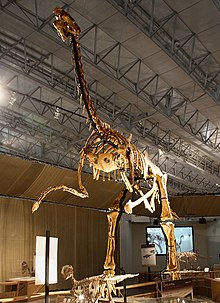
Oviraptor is a genus of oviraptorid dinosaur that lived in Asia during the Late Cretaceous period. The first remains were collected from the Djadokhta Formation of Mongolia in 1923 during a paleontological expedition led by Roy Chapman Andrews, and in the following year the genus and type species Oviraptor philoceratops were named by Henry Fairfield Osborn. The genus name refers to the initial thought of egg-stealing habits, and the specific name was intended to reinforce this view indicating a preference over ceratopsian eggs. Despite the fact that numerous specimens have been referred to the genus, Oviraptor is only known from a single partial skeleton regarded as the holotype, as well as a nest of about fifteen eggs and several small fragments from a juvenile.

Segnosaurus is a genus of therizinosaurid dinosaur that lived in what is now southeastern Mongolia during the Late Cretaceous, about 102–86 million years ago. Multiple incomplete but well-preserved specimens were discovered in the Gobi Desert in the 1970s, and in 1979 the genus and species Segnosaurus galbinensis were named. The generic name Segnosaurus means "slow lizard" and the specific name galbinensis refers to the Galbin region. The known material of this dinosaur includes the lower jaw, neck and tail vertebrae, the pelvis, shoulder girdle, and limb bones. Parts of the specimens have gone missing or become damaged since they were collected.

Oviraptoridae is a group of bird-like, herbivorous and omnivorous maniraptoran dinosaurs. Oviraptorids are characterized by their toothless, parrot-like beaks and, in some cases, elaborate crests. They were generally small, measuring between one and two metres long in most cases, though some possible oviraptorids were enormous. Oviraptorids are currently known only from the Late Cretaceous of Asia, with the most well-known species and complete specimens found only in the Gobi Desert of Mongolia and northwestern China.
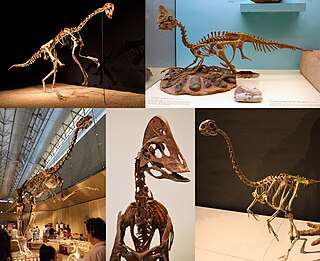
Oviraptorosaurs are a group of feathered maniraptoran dinosaurs from the Cretaceous Period of what are now Asia and North America. They are distinct for their characteristically short, beaked, parrot-like skulls, with or without bony crests atop the head. They ranged in size from Caudipteryx, which was the size of a turkey, to the 8-meter-long, 1.4-ton Gigantoraptor. The group is close to the ancestry of birds. Some researchers such as Maryanska et al (2002) and Osmólska et al. (2004) have proposed that they may represent primitive flightless birds. The most complete oviraptorosaur specimens have been found in Asia. The North American oviraptorosaur record is sparse.

Alectrosaurus is a genus of tyrannosauroid theropod dinosaur that lived in Asia during the Late Cretaceous period, about some 96 million years ago in what is now the Iren Dabasu Formation.

Caenagnathasia is a small caenagnathid oviraptorosaurian theropod from the Late Cretaceous of Uzbekistan.

The Bayan Shireh Formation is a geological formation in Mongolia, that dates to the Cretaceous period. It was first described and established by Vasiliev et al. 1959.

Hagryphus is a monospecific genus of caenagnathid dinosaur from southern Utah that lived during the Late Cretaceous in what is now the Kaiparowits Formation of the Grand Staircase–Escalante National Monument. The type and only species, Hagryphus giganteus, is known only from an incomplete but articulated left manus and the distal portion of the left radius. It was named in 2005 by Lindsay E. Zanno and Scott D. Sampson. Hagryphus has an estimated length of 2.4–3 metres and weight of 50 kilograms.

Caenagnathus is a genus of caenagnathid oviraptorosaurian dinosaur from the late Cretaceous period. It is known from partial remains including lower jaws, a tail vertebra, hand bones, and hind limbs, all found in the Dinosaur Park Formation of Alberta, Canada. Caenagnathus measured about 2.5 m (8.2 ft) long and weighed about 96–100 kg (212–220 lb).
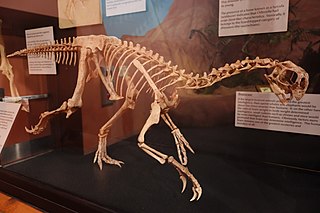
Heyuannia is a genus of oviraptorid dinosaur that lived in Asia during the Late Cretaceous epoch, in what is now China and Mongolia. It was the first oviraptorid found in China; most others were found in neighbouring Mongolia. Two species are known: H. huangi, named by Lü Junchang in 2002 from the Dalangshan Formation; and H. yanshini, originally named as a separate genus Ingenia from the Barun Goyot Formation by Rinchen Barsbold in 1981, and later renamed to Ajancingenia in 2013 due to the preoccupation of Ingenia. The latter name was eventually discarded due to various ethical issues surrounding the author.

Nemegtomaia is a genus of oviraptorid dinosaur from what is now Mongolia that lived in the Late Cretaceous Period, about 70 million years ago. The first specimen was found in 1996, and became the basis of the new genus and species N. barsboldi in 2004. The original genus name was Nemegtia, but this was changed to Nemegtomaia in 2005, as the former name was preoccupied. The first part of the generic name refers to the Nemegt Basin, where the animal was found, and the second part means "good mother", in reference to the fact that oviraptorids are known to have brooded their eggs. The specific name honours the palaeontologist Rinchen Barsbold. Two more specimens were found in 2007, one of which was found on top of a nest with eggs, but the dinosaur had received its genus name before it was found associated with eggs.

Caenagnathidae is a family of derived caenagnathoid dinosaurs from the Cretaceous of North America and Asia. They are a member of the Oviraptorosauria, and relatives of the Oviraptoridae. Like other oviraptorosaurs, caenagnathids had specialized beaks, long necks, and short tails, and would have been covered in feathers. The relationships of caenagnathids were long a puzzle. The family was originally named by Raymond Martin Sternberg in 1940 as a family of flightless birds. The discovery of skeletons of the related oviraptorids revealed that they were in fact non-avian theropods, and the discovery of more complete caenagnathid remains revealed that Chirostenotes pergracilis, originally named on the basis of a pair of hands, and Citipes elegans, originally thought to be an ornithomimid, named from a foot, were caenagnathids as well.
The Iren Dabasu Formation is a Late Cretaceous geologic formation in the Iren Nor region of Inner Mongolia. Dinosaur remains diagnostic to the genus level are among the fossils that have been recovered from the formation. The formation was first described and defined by Henry Fairfield Osborn in 1922 and it is located in the Iren Nor region of China.
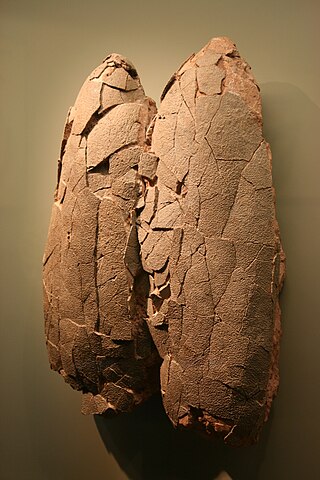
Macroelongatoolithus is an oogenus of large theropod dinosaur eggs, representing the eggs of giant caenagnathid oviraptorosaurs. They are known from Asia and from North America. Historically, several oospecies have been assigned to Macroelongatoolithus, however they are all now considered to be a single oospecies: M. carlylensis.

Ganzhousaurus is an extinct genus of oviraptorid dinosaur known from the Late Cretaceous Nanxiong Formation of Nankang County, Ganzhou City of Jiangxi Province, southern China. It was found in a Maastrichtian deposit and contains a single species, Ganzhousaurus nankangensis. It is distinguished by a combination of primitive and derived features.

Nankangia is an extinct genus of caenagnathoid oviraptorosaurian dinosaur known from the Upper Cretaceous Nanxiong Formation of Nankang County, Ganzhou City of Jiangxi Province, southeastern China. It contains a single species, Nankangia jiangxiensis. N. jiangxiensis coexisted with at least four other caenagnathoids, including but not limited to Corythoraptor, Banji, Ganzhousaurus and Jiangxisaurus. The relatively short dentary and non-downturned mandibular symphysis of Nankangia suggest that it may have been more herbivorous than carnivorous. Its diet consisted of leaves and seeds.

This timeline of oviraptorosaur research is a chronological listing of events in the history of paleontology focused on the oviraptorosaurs, a group of beaked, bird-like theropod dinosaurs. The early history of oviraptorosaur paleontology is characterized by taxonomic confusion due to the unusual characteristics of these dinosaurs. When initially described in 1924 Oviraptor itself was thought to be a member of the Ornithomimidae, popularly known as the "ostrich" dinosaurs, because both taxa share toothless beaks. Early caenagnathid oviraptorosaur discoveries like Caenagnathus itself were also incorrectly classified at the time, having been misidentified as birds.
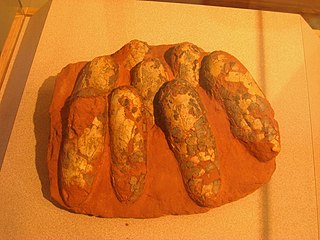
Elongatoolithidae is an oofamily of fossil eggs, representing the eggs of oviraptorosaurs. They are known for their highly elongated shape. Elongatoolithids have been found in Europe, Asia, and both North and South America.

Tsagandelta is a genus of deltatheroidean therian mammal that lived in Asia during the Late Cretaceous. Distantly related to modern marsupials, it is part of Deltatheroida, a lineage of carnivorous metatherians common in the Cretaceous of Asia and among the most successful non-theropod carnivores of the region. It represents the first known mammal from the Bayan Shireh Formation.

Beibeilong is a genus of large caenagnathid dinosaurs that lived in Asia during the Late Cretaceous epoch, about 96 million to 88 million years ago. The genus contains a single species, Beibeilong sinensis. The species was named and described in 2017 through analysis of an embryonic skeleton and partial nest with large eggs that were discovered in the Gaogou Formation of China between 1992 and 1993.
